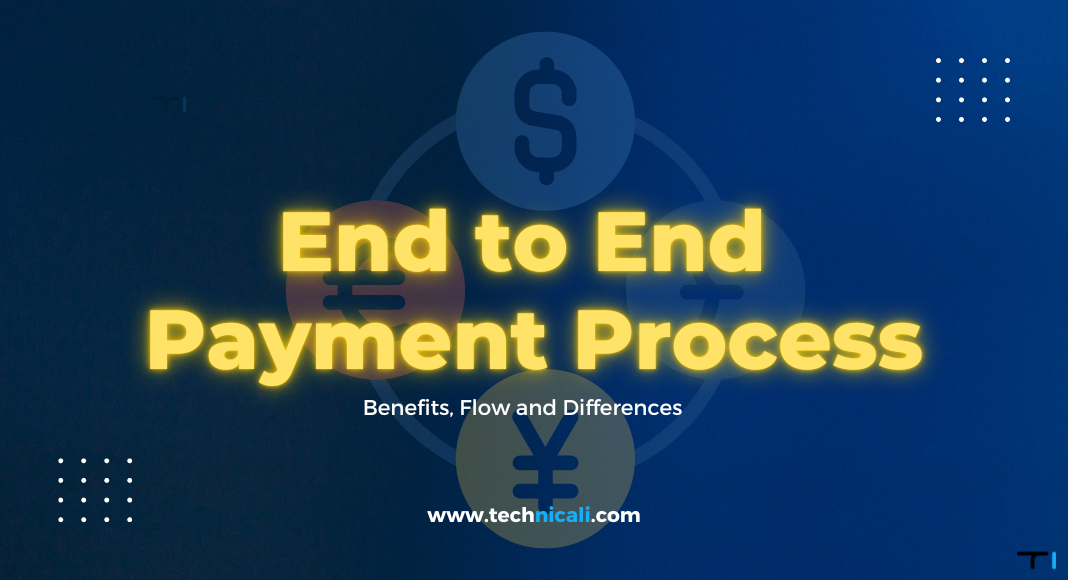You’ve been running your small business for a while now and have outgrown your payment processing system. It’s time to find an end-to-end payments processor that can handle all of your transactions, from start to finish. So, where do you begin?
The process of payment can seem daunting, but don’t worry – we’re here to help. In this article, we’ll explain everything you need to know about payment processors and the flow of payments. We’ll also introduce you to some of the most popular payment processors on the market today.
So, what are end-to-end payments? And what does a payment processor do? Keep reading to find out!
Contents
- 1 What is an End-to-End Payment Process?
- 2 Benefits of End-to-End Payment Processors
- 3 What is the Flow of Payments in the End-to-End Payment Process?
- 4 What is the Inbound and Outbound Payment Process?
- 5 Difference between End-to-End Payment Processors and Back-End Payment Processors
- 6 How to Choose the Right Payment Gateway for your Business
- 7 Tips for Using your Payment Processing Safely and Securely
- 8 Closing Words
What is an End-to-End Payment Process?

End-to-end payments are a type of payment processing that covers the entire spectrum of payment types – from point-of-sale (POS) transactions to ACH transfers. In other words, an end-to-end payment processor can handle all of your payment needs in one place.
The process of payment has become increasingly important in the modern age. With more and more businesses moving online, it’s essential that you have a payment processor that can handle all of your transactions securely and efficiently. An end-to-end payment gateway is the best way to ensure smooth and seamless payment transactions for your customers.
Not only is the end-to-end process necessary for your customers, but it’s also an essential aspect of any strategic business. An excellent centralised payment gateway can help you save time and money by automating many payment processing tasks necessary to running your business.
Benefits of End-to-End Payment Processors
One of the benefits of integrating end-to-end payment processing is that it can save you time and money. Instead of having to use multiple payment processors for different types of payments, you can streamline the process by using one provider for everything. This also eliminates the need to reconcile multiple sales channels and statements from different processors – saving you even more time!

In addition to saving time and money, end-to-end payment processors offer a number of other benefits, including:
- Increased Security: When you use one provider for all of your payment needs, you can rest assured knowing that your data is safe. End-to-end payment processors use the latest security technologies to protect your information – meaning you can focus on running your business, not worrying about fraud.
- Greater Flexibility: End-to-end payment processors offer a wide range of payment options, so you can tailor the payment experience to fit your business’s needs. Whether you need to accept credit cards, debit cards, or even cryptocurrency, an end-to-end processor has you covered.
- Greater Efficiency: By automating many of the tasks associated with payment processing, end-to-end processors can help you streamline your operations. This means you can spend less time on administrative tasks and more time growing your business.
- Improved CX and Satisfaction: When customers have a seamless payment experience, they’re more likely to be satisfied with your business. An end-to-end payment processor can help you provide a positive customer payment experience, leading to repeat business and referrals.
- Increased Sales: A good payment processor can help you increase sales by offering recurring billing and subscription management features. With an end-to-end payment processor, you can take advantage of these powerful features to boost your bottom line.
- Omnichannel Experience: An end-to-end payment processor can help you provide a consistent payment experience across all channels – from your website to your brick-and-mortar store. This omnichannel payment transactions approach can help you build customer loyalty and increase sales.
- More Bisibility and Real-Time Reports: When you have all your payment data in one place, it’s easier to track your performance and identify areas for improvement and customer trends. An end-to-end payment processor can give you the visibility you need to make informed decisions about your business.
- Scalability: The payment platform scales automatically to meet the demands of your business – meaning you never have to worry about capacity issues. This can save you time and money in the long run, as you won’t need to invest in additional infrastructure to support your growth.
These are just a few of the most important ones. Other than the above, end-to-end payment processing offers many advantages over traditional payment processors, including faster innovation, more payment options, improved customer lifetime value, and managing the reconciliation process for your accounting needs.
What is the Flow of Payments in the End-to-End Payment Process?
The end-to-end payment cycle will manage all the different steps in the centralised payment gateway. This includes gathering information from the customer, authorising the payment, and depositing the funds into the merchant account.

The entire process of managing payments processing becomes seamless and efficient, with no complex systems, interruptions, or delays.
An example of how this would work is as follows:
- A customer goes to a store’s website and selects items to purchase.
- When the customer finalises the items they wish to purchase, they are directed to the checkout page.
- Here, the customer enters their payment information into the system. This can be done through a variety of methods such as chip and PIN, contactless, or swipe.
- The end-to-end payments processor then communicates with the payment network to verify the payment information and authorise the transaction.
- Once the payment is authorised, the funds are transferred from the customer’s account to the merchant’s account.
- The merchant can then withdraw these funds and use them for their business needs.
In this case of the flow of the payment cycle, the merchant will get payment from the customer, and the customer’s payment information got verified by their end-to-end solution.
What is the Inbound and Outbound Payment Process?
In the inbound payment process, customers send payments to businesses. This can be done through a variety of methods such as credit cards, debit cards, or even cryptocurrency. In contrast, outbound payments are when businesses send payments to their suppliers or vendors.

Just like in the case of the flow of payments, the end-to-end payment processor will manage all the different steps in both the inbound and outbound payment processes. This includes gathering information from the customer or merchant, authorising the payment, and depositing the funds into the appropriate account.
Inbound Payment Process:
The inbound payment process begins when the customer clicks the checkout button on your website. The end-to-end payments processor will then capture the customer’s information and send it to the payment network. The payment network will then approve or decline the transaction. If consented, the funds will be transferred from the customer’s bank account to your bank account.
Outbound Payment Process:
Processing payments in outbound begins when you receive an order from a customer. You will then generate an invoice and send it to the end-to-end payments processor. The end-to-end payments processor will then charge the customer’s bank account and transfer the funds to your issuing bank account.
The entire approach is seamless and efficient, with no interruptions or delays.
Difference between End-to-End Payment Processors and Back-End Payment Processors

A back-end payment solution is a company that provides the infrastructure and services needed to process customer payments. This can include things such as credit card processing, ACH processing, and check processing.
In contrast, an end-to-end payment processor is a company that provides all the services needed to process customer payments from start to finish. This includes the entire solution, from gathering customer information to authorising the amount to deposit the funds into the merchant’s account.
End-to-end payment processors offer several benefits over traditional merchant payment processors discussed in the above section. It allows you to focus on your business while they handle all the payment processing for you.
How to Choose the Right Payment Gateway for your Business
When it comes to choosing the right payment ecosystem for your business, there are a few things you need to take into account.
The first is selecting the type of customer-merchant services you need. A back-end payment processor will be fine if you only need credit card processing. However, if you need all the services required to process payments from start to finish, then you will need an end-to-end payment processor.
The second thing you need to consider is the size of your business. The end-to-end provider typically has a minimum transaction requirement for a complete functional solution, so make sure your company meets that requirement.
The third thing you need to consider is the company’s reputation and track record. Centralising transactions takes a lot of trust while giving you more control and visibility over your payment data. Make sure the payment processor has a good reputation and is known for providing quality service.
Finally, make sure to read the payment processor’s terms and conditions carefully before signing up. In this age of digital transformation, it’s essential to know exactly what you’re getting into, ensuring that you are aware of all the costs and fees associated with using their services.
Tips for Using your Payment Processing Safely and Securely

You can do a few things to help ensure that your payment processor is used safely and securely.
- Make sure your processor is PCI-DSS compliant. This is the Payment Card Industry Data Security Standard, and it is a set of requirements designed to ensure that all companies that process credit cards are keeping customer data safe.
- Make sure that the end-to-end payment processor you are using is reputable and has a strong security track record in the payments industry.
- Always use a secure connection (SSL/https) when logging in to your account or entering your payment information.
- Be careful when clicking on links in emails or online ads – only click on links from sources you trust.
- Keep your login credentials and payment information confidential – do not share them with anyone else.
- Update your anti-virus software and firewall protection regularly, and frequently scan your computer for malware infections.
- Choose a payment processor that offers fraud protection services, such as chargeback protection or fraud monitoring.
- Check your account regularly to make sure all charges are correct.
- Back up your data regularly, both onsite and offsite.
- Report any suspicious activity immediately to the payment processor’s customer service department.
Closing Words
If you’re looking for a comprehensive payment processing solution, an end-to-end payment gateway is a way to go. These gateways can handle all of your transactions, from start to finish. Plus, they offer a wide range of features and benefits that can make your business run more smoothly.
To learn more about end-to-end payments and the different payment gateways available on the market today, be sure to check out our other articles on this topic.
We’ve got everything you need to make an informed decision about your business’ payment processing needs.
Did you find this article helpful? Share your thoughts in the comments below!



I’m impressed, I must say. Really rarely do I encounter a blog that’s each educative and entertaining, and let me tell you, you’ve got hit the nail on the head. Your thought is outstanding; the difficulty is one thing that not sufficient individuals are talking intelligently about. I am very happy that I stumbled throughout this in my search for something relating to this.